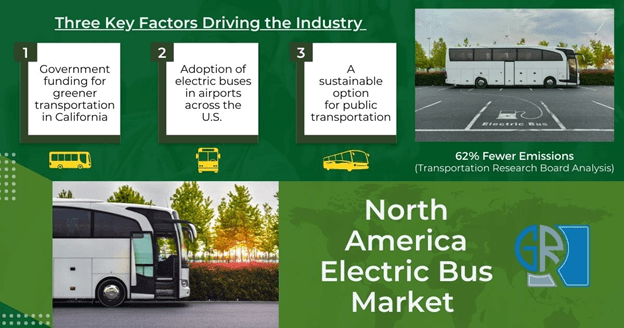With the support of state & federal governments in the form of subsidies and grants for vehicle adoption, North America electric bus market is presently undergoing significant expansion. Building a sustainable transportation system has been a top priority for cities throughout the world, with the objective of providing a well-connected, seamless mobility experience while decreasing traffic, noise, and pollution.
Battery-electric buses are known to be the lowest-carbon alternative vehicle in every region of the United States. According to a Transportation Research Board analysis, an electric bus emits 62% fewer emissions than a diesel bus. Banking on these features, governments across the globe are replacing diesel buses with electric buses.
Several cities in North America are seeking to switch their whole fleet to electric. The New York City, which has the largest bus fleet in the country, plans to go all-electric by 2040.
With the industry noting these advancements, it is expected that North America electric bus market size will garner considerable revenue in the upcoming years. Considered below are the three key factors driving the industry forward:

Government funding for greener transportation in California
The California Air Resources Board (CARB) has overseen a number of state-funded award programs aimed at encouraging the deployment of zero-emission buses across the state. The Project for Hybrid and Zero-Emission Truck and Bus Vouchers (HVIP), for example, provides a discount at the point of sale for clean buses with no scrappage regulations.
The scheme offers up to $175,000 in point-of-sale price savings for qualified electric buses. Powered by such initiatives, the West Coast is currently at the forefront of electric bus deployment. Wide-scale deployment of these products across California are driven by the state’s ambition of converting all its transit buses to zero-emission buses by the end of 2040.
Financial assistance provided by numerous government-funded initiatives has resulted in large-scale deployment of zero-emission buses in California. Around $100 million are invested in a diverse portfolio of transportation and fuel transportation projects throughout the region each year.
Adoption of electric buses in airports across the U.S.
Over the past decade, several federal incentives have aided transport operators in the region to enhance product adoption, fueling U.S. electric bus industry forecast. With adequate government support, almost every state in the U.S. has a transportation agency that owns or plans to own new electric buses. Through the Low or No Emission Bus Program, the FTA granted about $485 million between 2013 and 2020 for hybrid, battery-electric, and hydrogen fuel cell buses.
Several airports in the United States have implemented zero-emission transportation and small buses. These buses are commonly employed to convey passengers from parking lots to airport terminals. Airports have deployed or purchased a substantial number of zero-emission transit-style buses to far. These zero-emission airport shuttles are all battery-powered. California is registering growing number of zero-emission airport bus deployments, thereby supporting the electric bus market in North America.
A sustainable option for public transportation
In January 2021, the Governor of New York announced plans to grant $16.4 million in incentives for the deployment of electric buses among public transportation agencies under the Volkswagen settlement fund. The Biden administration's aim to make all new American-built buses zero-emissions by 2030 is considered as a big benefit to regional e-bus manufacturers, providing access to key resources to electrify transportation and increase domestic sales.
Leading electric bus manufacturers, such as BYD, Proterra, and Yutong have been experimenting with a slew of business strategies to attract customer attention. In 2019, Proterra introduced a battery leasing program to reduce upfront costs and provide attractive financing choices for transit purchasers in North America electric bus industry. The company also added a battery production line to its Los Angeles County electric transit bus manufacturing facility. Later this year, the company plans to complete a reverse merger with ArcLight Clean Transition Corp, a special purpose acquisition company (SPAC).


